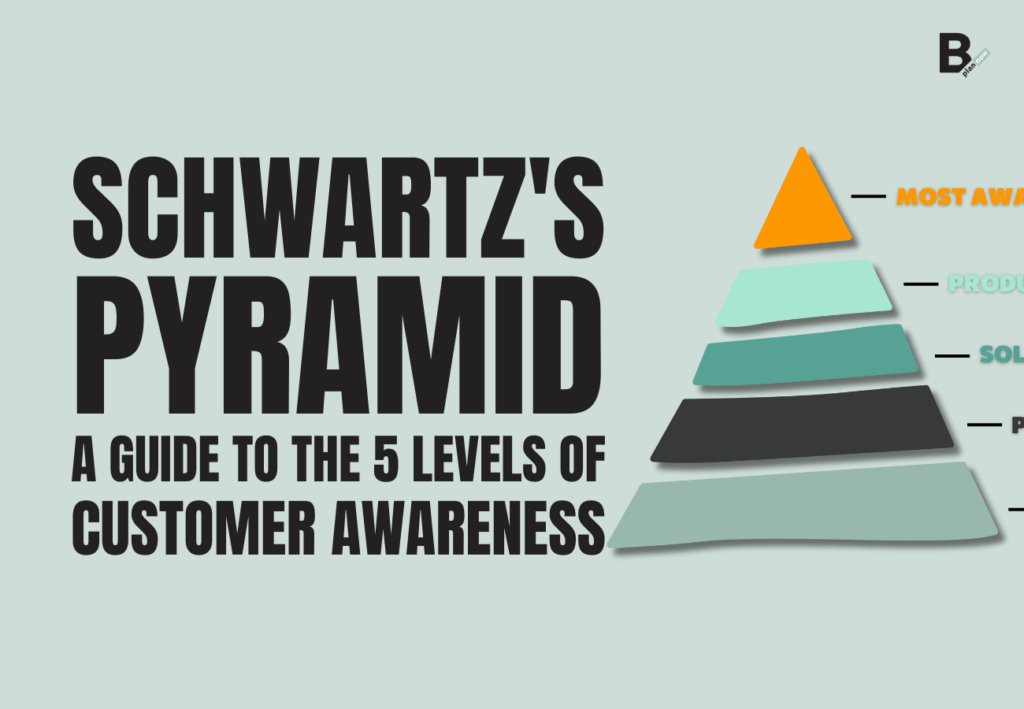If you want to increase the number of clients for your business, you cannot ignore Eugene Schwartz and his Pyramid of Awareness, also known as the Schwartz Pyramid. The model theorized by the copywriter, author of the famous book Breakthrough Advertising, is at the center of this guide: here you’ll find a detailed explanation of what the Schwartz Pyramid is and how it works, along with the best advice on how to use it in marketing and communication for your startup.
What is Schwartz’s Pyramid of Awareness
The Pyramid of Awareness levels described in detail in the already mentioned book Breakthrough Advertising. According to Eugene Schwartz, consumers’ ability to absorb advertising messages varies depending on their degree of knowledge (or awareness) of the product or service and of their needs, problems, and desires. The levels that make up Schwartz’s Pyramid are five.
What it’s for and why it’s still relevant
The Pyramid of Awareness levels helps to understand the motivations behind consumer purchases and, as a result, to make advertising messages more effective. At each level, a different approach is required to stand out from competitors and trigger the desired emotional response.
Today, competition is fiercer than ever, and standing out is an increasingly urgent need. For this reason (and many others), Schwartz’s Pyramid remains highly effective.
The 5 levels of awareness according to Schwartz
As mentioned, the levels of awareness in Schwartz’s Pyramid are five. Awareness increases vertically, from the base to the top of the pyramid.
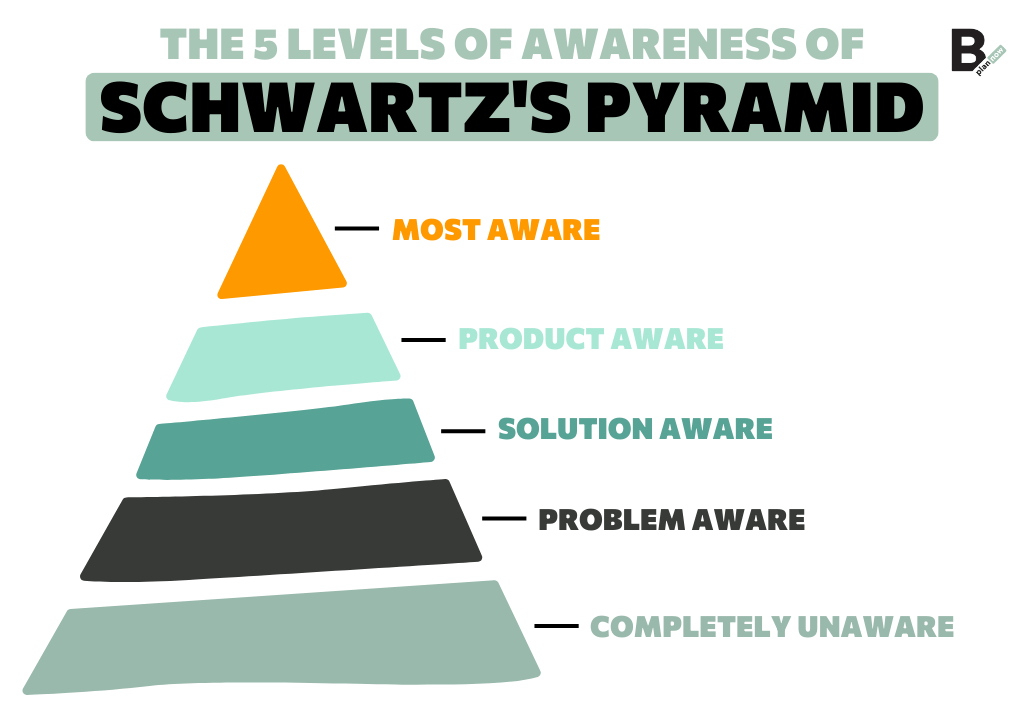
1. Unaware: those who don’t know they have a problem
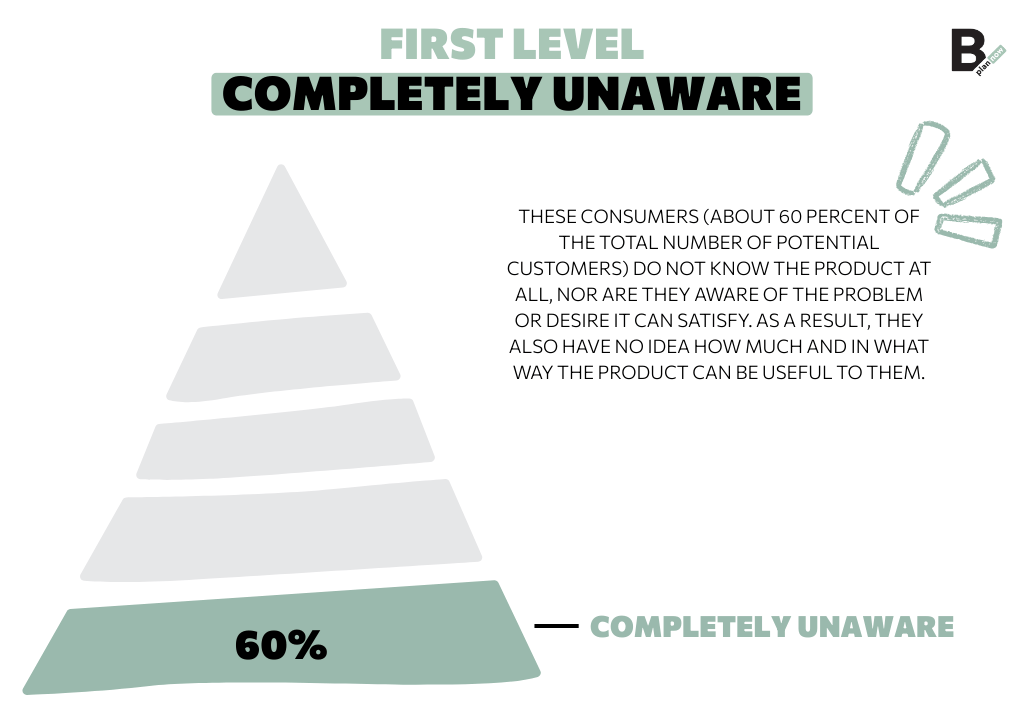
The first level is that of unawareness: these consumers (about 60% of total potential customers) don’t know the product at all, nor are they aware of the problem or desire that it can satisfy. Consequently, they don’t have the slightest idea of how much and in what way the product can be useful to them.
It won’t surprise you to know that this is the most difficult group of consumers to reach. To succeed, it’s necessary to create demand by highlighting the problem. It’s useless to resort to overly technical or specific information because consumers aren’t able to grasp its importance. A less direct approach is more useful, based on evocative images and suggestions.
2. Problem Aware: those who have a need but not the solution
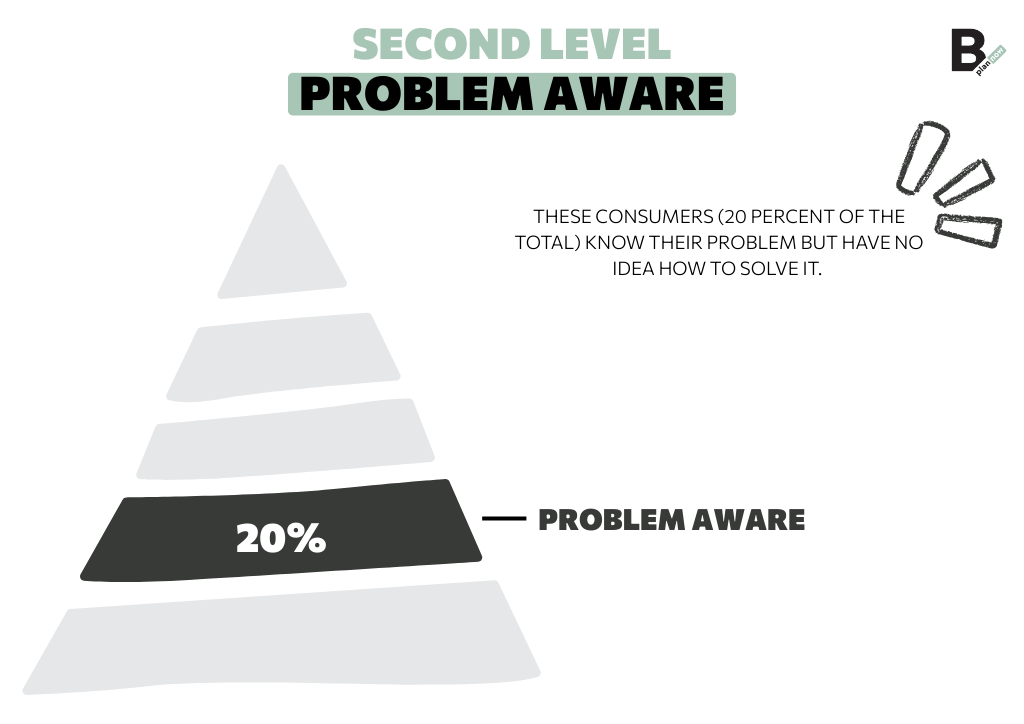
The second level is that of problem awareness: these consumers (20% of the total) know their problem but have no idea how to solve it. To reach this type of audience, you need to explain to them that there is a solution to what “troubles” them, using empathetic language and also creating a bit of mystery. Always remember this famous maxim by Eugene Schwartz:
“No sentence can be effective if it contains only facts. It must also contain emotion, image, logic and promise.”
3. Solution Aware: those who are looking for the answer
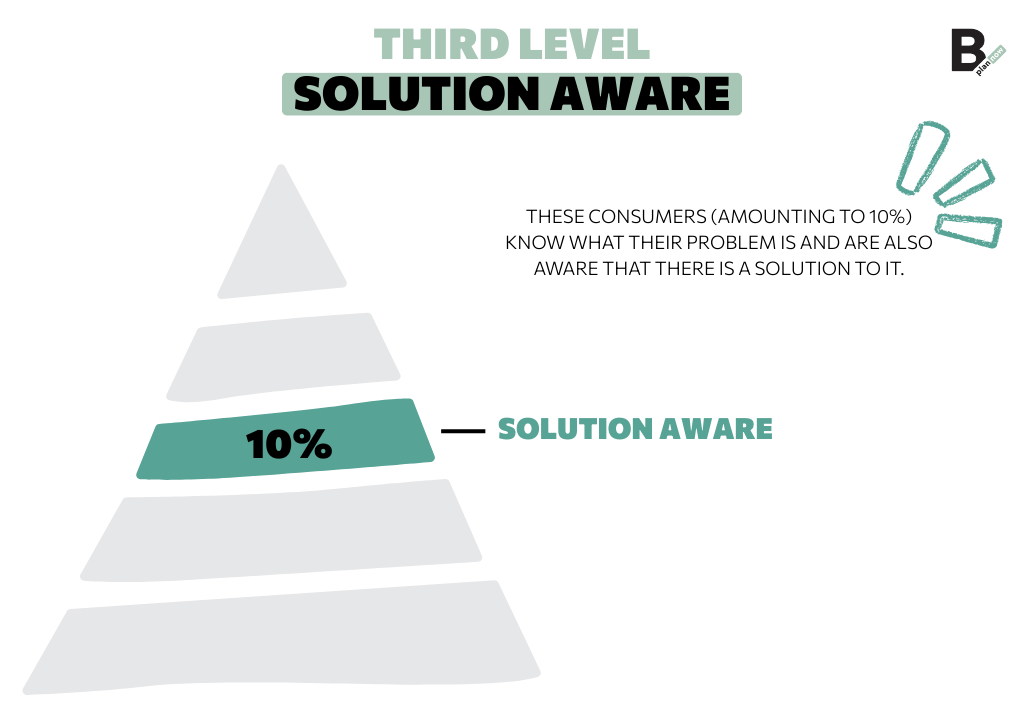
In the middle of the pyramid is the third level, that of solution awareness: these consumers (equal to 10%) know what their problem is and are also aware that a solution to it exists. To convince them to buy your product, you need to explain to them that it represents the best option available to them, using persuasive phrases and positive testimonials from those who have already bought and used it.
4. Product Aware: those who are evaluating alternatives
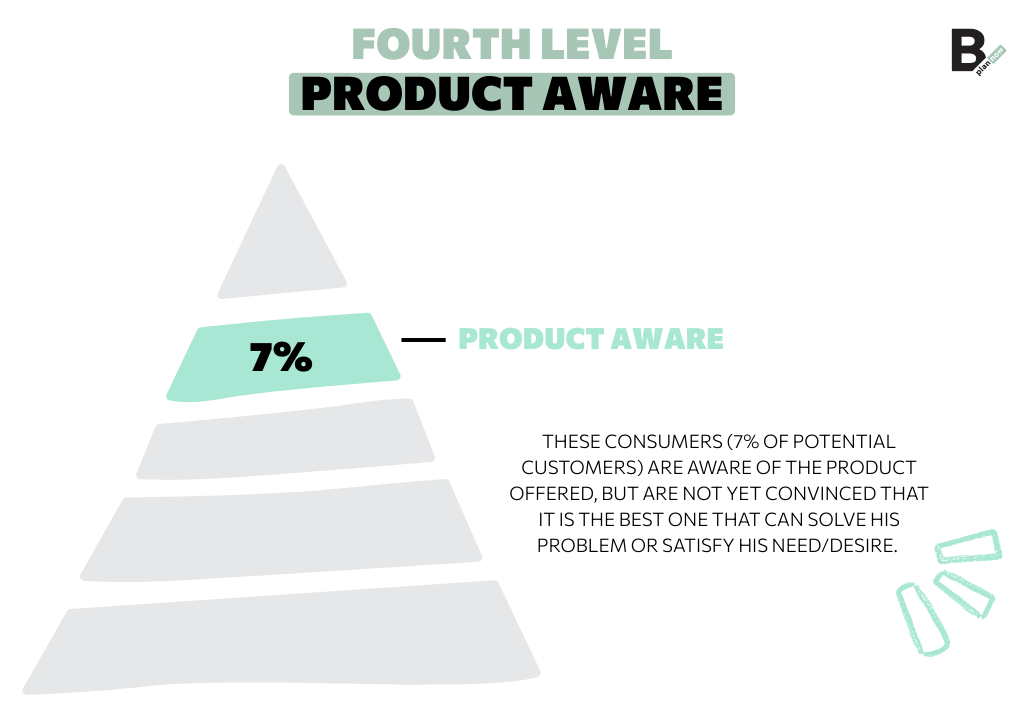
The fourth level of Schwartz’s pyramid is that of product awareness: these consumers (7% of potential customers) are aware of the product offered, but aren’t yet convinced that it’s the best one able to solve their problem or satisfy their need/desire. You should know that, often, the hesitation to proceed with the purchase is linked to price reasons. These consumers, therefore, are particularly susceptible to information about discounts and offers. Remember that you need to convince them that the alternative you’re proposing is the best solution on the market in terms of quality/price ratio.
5. Most Aware: those who are ready to buy
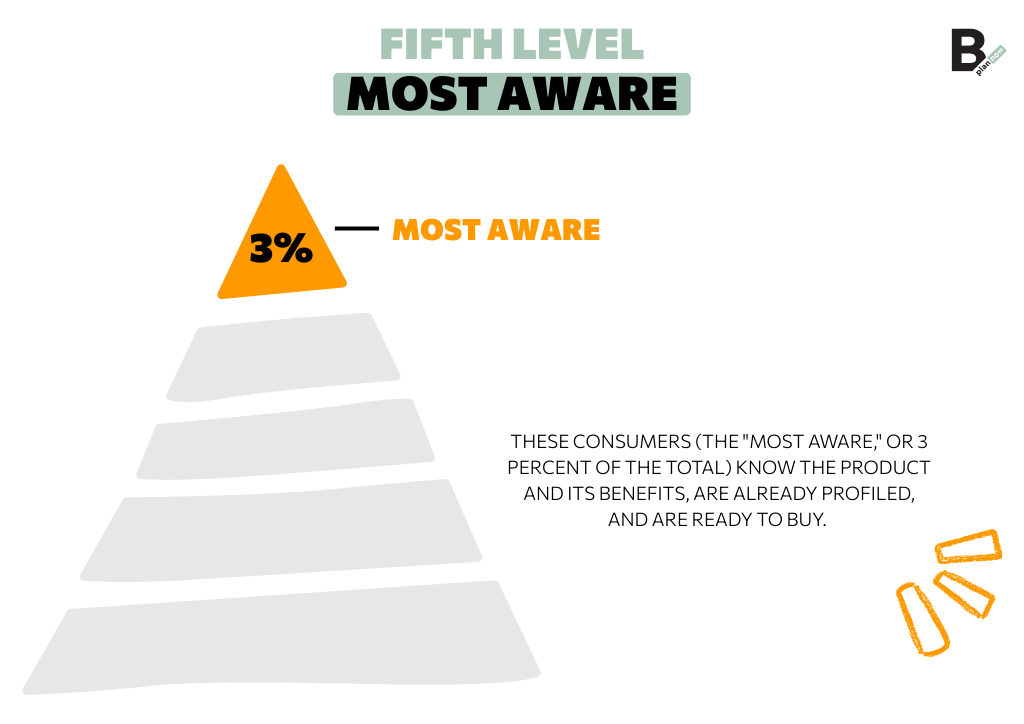
The last level is that of full awareness: these consumers (the “most aware,” that is, 3% of the total) know the product and the advantages it offers, are already profiled and are ready to buy. They’re just waiting for you to communicate an irresistible offer to them. Consumers who fall into this category, therefore, are the easiest to convince. The mistake you shouldn’t make, however, is to address only and exclusively these customers.
How to use the pyramid in communication and marketing
In the following lines you’ll discover, in more detail, how you can leverage Schwartz’s awareness pyramid for your business model, particularly regarding communication and marketing strategies.
Adapting the message to the awareness level
The first indication is a fundamental principle that lies at the basis of this particular model: you must adapt the message to the awareness level of the consumers you’re addressing. As you’ve already seen, at each level, people respond more effectively to different messages.
Effective tools, examples and approaches
The best approach to effectively use Schwartz’s teachings is to lead your potential customers to become aware, first of all, of the problem, need or desire they have, before leading them to go through each level until they reach the moment when they’ll make the purchase.
Each level corresponds to particular tools you can use to achieve the goal, from emotional videos when you most need to focus on suggestions to reviews, testimonials and case histories when you need to leverage the “social proof” principle.
The most common mistakes to avoid
The main mistake to avoid when talking about Schwartz’s pyramid is not differentiating messages based on the type of consumer you’re dealing with or building them on wrong assumptions, that is, ones that don’t take into account what consumers are actually aware of.
Another mistake, already mentioned, is to direct your attention only and exclusively to the “easiest” consumers to convince, that is, that 3% of potential customers who are already ready to buy.
Schwartz’s pyramid for startups
You should know, now, that Schwartz’s awareness pyramid can prove particularly useful for startups. But under certain conditions.
How to segment the target when the product is innovative
When the product offered is particularly innovative, the segmentation of the target audience must proceed in a more flexible way, as well as a broader one. Market division must be based not only on needs, desires and interests, but also on attitudes toward innovation, identifying the so-called early adopters, that is, those who will try the product first.
Communicating when the problem is not yet perceived
When the problem is not yet perceived by consumers, it’s useless to focus communication on the product, dwelling on technicalities and data as proof of its benefits. The first step must be to create the conditions for all that information to become relevant to consumers. It’s necessary, therefore, to raise the problem and bring out in consumers the awareness of needing a solution. Precisely your solution.
Educating the market: from latent demand to conversion
A few lines above we already said that the path to follow is one that allows you, first and foremost, to lead consumers to become aware of the existence of a problem and then lead them to complete the conversion.
Generally, companies try to intercept a latent demand, which is already present but not yet satisfied. In more practical terms, in the market there exists a problem to satisfy but not its solution. When the product is innovative, however, the concept of latent demand changes: the goal, in this case, is to capture a need that doesn’t yet exist (or, rather, hasn’t been revealed) within the market. The purpose of a startup, in summary, is to generate a need where it’s already possible to identify an opportunity.
The consumer must, therefore, first become aware of the problem, need or desire they have, and then proceed with the purchase of that product that can solve or satisfy it. The proposed solution – remember – must be easily understandable by the consumer.
From theory to practice: how to apply the model
The transition from theory to practice isn’t always easy. In the following paragraphs you’ll find some valuable indications for concretely implementing the best strategies to leverage Schwartz’s pyramid to your advantage.
Creating funnels and personalized content
The creation of marketing funnels and personalized content becomes fundamental when, to guide the potential customer toward purchase, you must necessarily take into account their level of awareness regarding the product to buy. As already widely emphasized, in fact, a particular type of content can be relevant and effective for one consumer, but not for another, precisely based on how aware the consumer themselves is of having a problem to solve or a need to satisfy.
Effective writing for each awareness phase
In this paragraph you’ll find briefly summarized the most effective content for each awareness level of Schwartz’s pyramid:
- Unaware: use evocative images and suggestions and avoid technicalities and overly specific information about product features.
- Problem Aware: use empathetic language and create a bit of mystery around the product.
- Solution Aware: resort to testimonials, reviews and case histories to demonstrate that your solution is better than others.
- Product Aware: focus your advertising communications on discounts and offers.
- Most Aware: communicate your irresistible offer by giving precise information about price and purchase method.
Why Schwartz’s pyramid remains relevant today
Before closing this guide dedicated to Schwartz’s awareness pyramid, it’s necessary to open a look at the present and toward the future. The reason is quickly stated: the model developed by the copywriter is still relevant today. And it will be tomorrow too.
A human-centered approach
The main strength of Schwartz’s pyramid lies in its human-centered approach. More than ever today, in fact, understanding why people behave in a certain way and buy (or don’t buy) a product is the decisive step that allows you to create an engaging emotional bond with them and facilitate, in this way, their path toward purchase.
Do you want to read all the articles related to the stage your startup is in?

